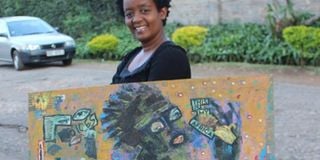KU lecturer wins global art prize

Artist Anne Mwiti, winner of the World Citizen Artist Competition 2014, with one of her earlier paintings. Ms Mwiti is a lecturer at Kenyatta University. PHOTO | MARGARETTA WA GACHERU | NATION MEDIA GROUP
What you need to know:
- Inaugural World Citizen Artist Competition had the theme of peace.
- Ms Anne Mwiti entered her painting for the contest and was shocked to win the overall prize.
Anne Mwiti has been a winner to many of her arts students at Kenyatta University for quite some time, at least since 1997 when she "graduated" from being a Master’s degree student of fine art and began teaching first years at the Kahawa campus.
But it took her winning the World Citizen Artist Competition 2014 this past December for a much wider audience to wake up to her imagination, ingenuity and artistry.
Recently returned from London where the 10 top winners of the competition were on exhibition at the Belgravia Gallery in Mayfair, there were many from all round the world who submitted their art online but didn’t make the cut.
Given a single topic, that of "peace", to conceptualise and then create a piece of artwork around, Anne’s mixed media painting was an abstract piece in mainly black and white, colours that occupied an equal amount of space on her canvas, the white symbolising peace, the black symbolic of war but also of her region which she said was still often referred to as the "dark continent".
The heavily textured black and white layers of her painting were divided by two thin horizontal lines, one red (for the blood sacrificed for the sake of peace, she told Saturday Nation) and green which she said was meant to symbolise greed, which is what she claimed was bottom line, the cause of most conflicts.
What was possibly the most conspicuous feature of her painting was the needle and white thread that she used to stitch, criss-cross, across the thin horizontal lines and then left hanging down against the black background, which is textured with gauze (the material she says most bandages are made of, used when repairing wounds people receive in times of war).
“The hanging thread represented each individual and his ability to decide either for war or for peace,” said Anne who sent a written explanation of the symbolic features of her painting when she submitted her work to London.
It was there that scores of artworks from around the world were judged in a competition co-sponsored by the Belgravia Gallery, Playing for Change Foundation and Issuu Publishers together with World Citizen Artist.
ONLY AFRICAN
Anne was stunned when she learned she’d won the competition, but as she was in UK at the time, she was able to attend the WCA opening at the Belgravia that featured the works of all 10 winning artists.
As was evident in the YouTube video of the opening, some of the 10 were Eastern European, others Asian, and at least one was from North America and UK.
Being the only African among the 10, Anne couldn’t help feeling humbled to de facto be representing not just Kenyan but African artists as a whole.
Not that other Africans couldn’t have submitted their artworks to the competition since its announcement was Online for all to see.
But frankly, Anne had the good fortune of being sent the Online link about the competition from a Ugandan curator whom she had met while participating in a continental exhibition on women held in Kinshasa earlier last year.
In fact, while Anne may be best known as a KU art lecturer in Kenya who has been in several group and solo exhibitions, she is probably more widely known across the region and now across the globe as the winner of the inaugural World Citizen Artist Competition.
For now, we can simply applaud Anne Mwiti for her success and look admiringly at her trophy, a hand-carved wooden globe covered with shiny silver metal birds, symbolic of peace.
And if one goes looking for Anne, you will still find her at KU lecturing in the fine art department, which has grown significantly in the past few years.
She’ll either be in a large lecture hall or teaching drawing or multi-media art and design to young art students who appreciate the way she combines the academic with a more popular, practising approach to art.
Admitting it’s not a common practice to combine the two at KU, she says she wouldn’t have it any other way.
“It’s hard work doing teaching during the day and my personal art late into the night, but it’s worth it. And I believe my students benefit in the process.”




